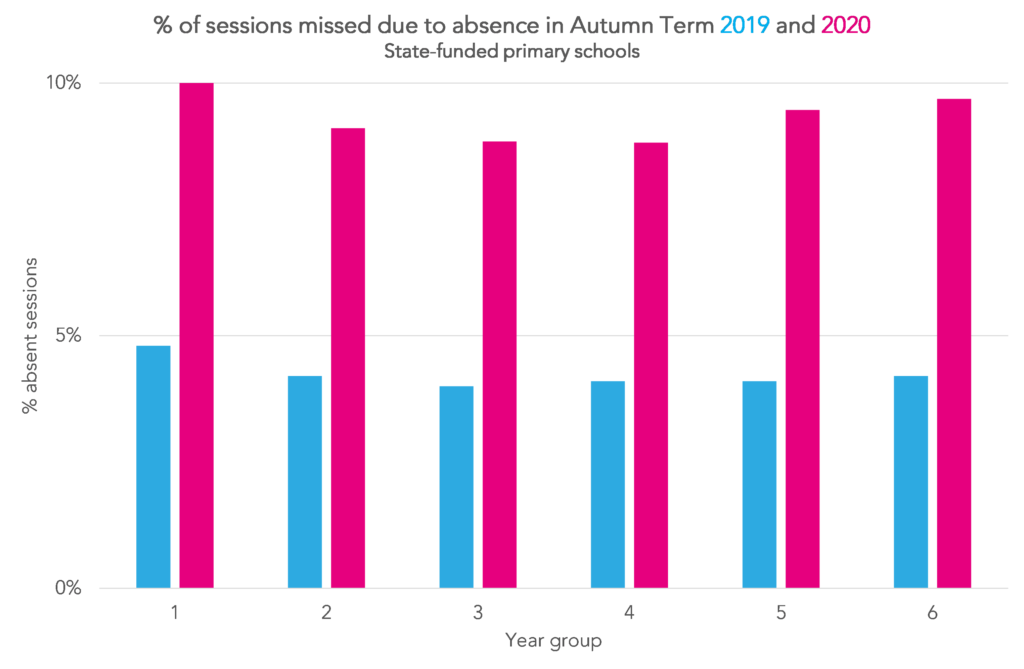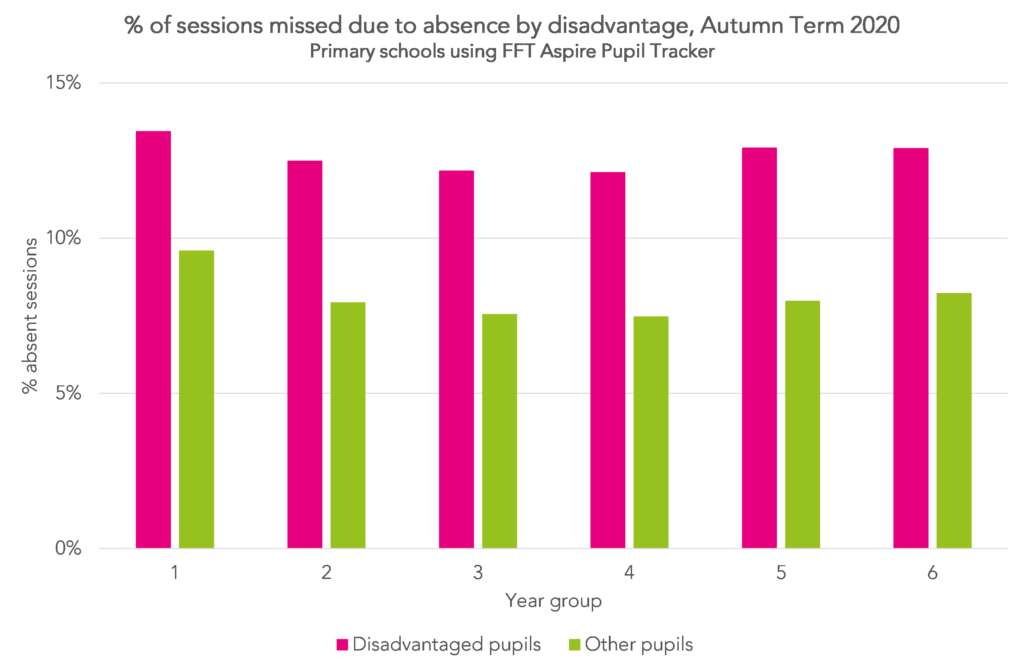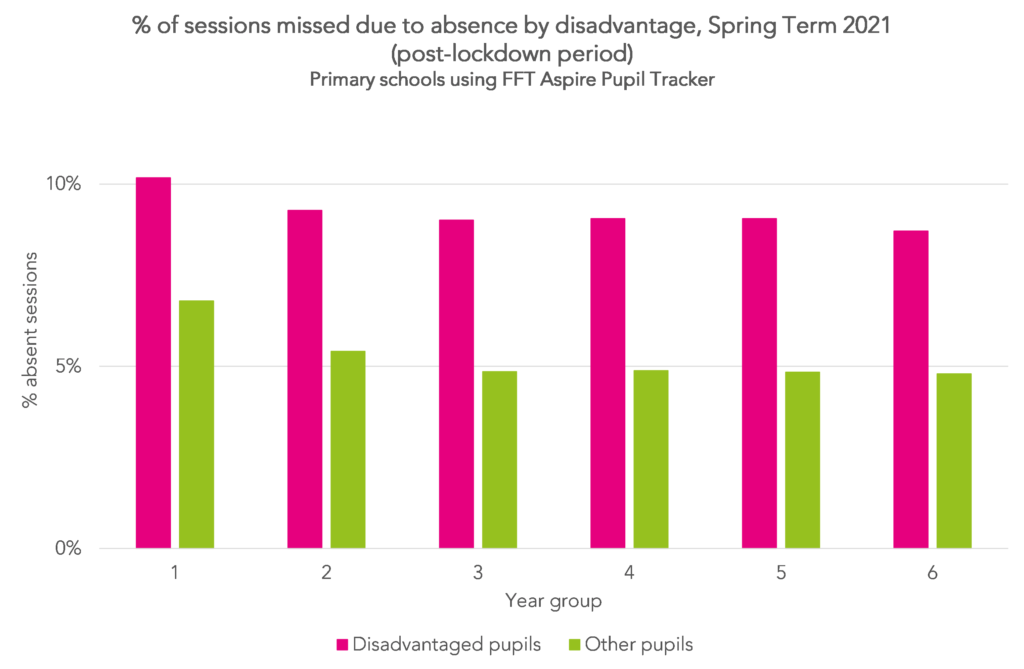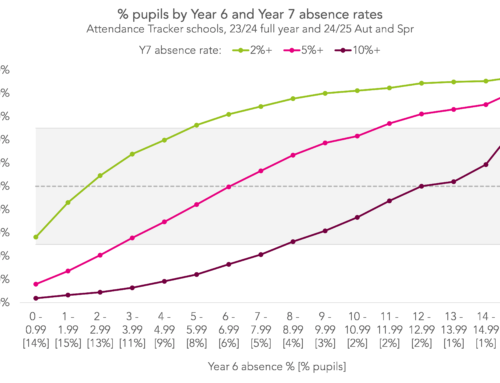Today we are launching FFT Aspire Attendance Tracker for primary schools.
Using the data we’ve collected so far, we’re now able to examine absence rates in primary schools for the Autumn term and from when most pupils returned to school following the latest lockdown.
This follows our post from a few weeks ago where we looked at how much school pupils in Year 11 missed in the Autumn Term.
Absence this year compared to pre-pandemic
The data we used for this post was collected via the FFT Aspire Attendance Tracker. Nearly 2,000 primary schools are currently using this tool to monitor and benchmark pupil attendance.
We’ll start by comparing the absence rates in these schools in Autumn Term 2020 to the national rates published by the Department for Education for the same period in 2019.
Unsurprisingly, absence rates during Autumn Term 2020 were much higher than in 2019 for all year groups. In both 2019 and 2020, absence was particularly high for the youngest pupils – pupils in Year 1 missed 10.5% of sessions in 2020, while pupils in Year 3 missed just 8.8% of sessions. In 2019, pupils from Year 2-6 missed a similar proportion of sessions, but in 2020 absence was higher for pupils in Years 5 and 6 than it was for pupils in Years 2-4.
Differences by year group during the Autumn Term
In the chart below, we look how absence by year group changed during the course of the Autumn Term.
Absence among Year 1 pupils compared to other year groups was much higher in the first couple of weeks of term, perhaps because of phased returns to school. But although the gap was smaller later in the term, it was still the case that in the majority of weeks, Year 1 missed more school than any other year group.
The impact of disadvantage
The next chart shows the proportion of sessions missed over the Autumn Term 2020, broken down by year group and whether pupils were disadvantaged.
There are some striking differences in the absence rate for disadvantaged pupils compared to other pupils. This perhaps isn’t surprising – it was the case pre-pandemic, and we saw exactly the same pattern when we looked at the same data for secondary schools.
In general, disadvantaged pupils missed 50% more sessions than other pupils, and the gap was wider for older pupils. Disadvantaged pupils in Year 1 missed 13.4% of sessions, while other pupils missed 9.6%, a gap of 3.8 percentage points; the gap for pupils in Year 6 was 4.7 percentage points.
We can also take a look at the data for the post-lockdown period of Spring Term 2021, when the majority of pupils returned to school. We have just a few weeks of data, covering the period from mid-March to early April, but it is enough to give us a sense of whether the patterns we saw in the Autumn Term continued into the Spring Term.
Aspire Attendance Tracker
Schools can track, analyse and compare their attendance data against 1,000s of other FFT schools using Aspire Attendance Tracker.
Available now for primary and secondary schools – log in here.
Not an FFT Aspire user? Learn more here.
As in the Autumn Term, there was an obvious difference in absence rates for disadvantaged and other pupils; once again, disadvantaged pupils missed around 50% more sessions than other pupils, and the disadvantage gap was lowest among the youngest pupils.
But there were also some differences. In the Autumn Term, pupils in Years 5 and 6 were more likely to be absent from school than those in Years 2-4; this wasn’t the case in Spring Term.
The disadvantage gap was also smaller in Spring Term than in Autumn Term – disadvantaged Year 6 pupils missed 12.9% of sessions in Autumn Term, compared with 8.2% of other pupils, a gap of 4.7 percentage points, while in Spring Term, disadvantaged pupils missed 8.7% of sessions and other pupils 4.8%, a gap of just 3.9 percentage points.
Finally, the absence rate was quite a bit lower than it was in Autumn Term. This is the case for all year groups; for Year 6 pupils, for example, the rate fell from 9.7% in the Autumn Term to 6.0% in the post-lockdown period of Spring Term.
Regional differences
Finally, a look at regional differences. We’ve written before about how attendance has varied across the country during the course of the pandemic. In the chart below, we look at how absence rates for Year 6 pupils varied by region during the course of the Autumn Term and the post-lockdown period of Spring Term.
During the earlier part of the Autumn Term they tended to be higher in the north of the country. But in the last few weeks, as the ‘Kent variant’ of COVID began to spread, they increased sharply in the East, the South East and London.
By the post-lockdown period in the Spring Term, absence rates were generally far lower than at the end of Autumn Term, particularly in those areas that were hard hit by the ‘Kent variant’, but they were generally increasing as the term went on.
The North East was a notable exception to this pattern, with a high absence rate – 19.2% for disadvantaged pupils – in the second week of the post-lockdown period, and a gradual decrease since then.
In every region, disadvantaged pupils missed more school than other pupils, although the gap was smaller in London than in other regions.
Summing up
The data that we used for this post was a relatively small sample of around 1,000 of the roughly 17,000 state-funded primary schools in England, and we haven’t taken any steps to ensure that it is representative, so it might be a bit of a leap to assume what we’ve found in this post applies to primary schools in general.
However, it does give us some evidence to suggest that disadvantaged primary pupils have missed out on more school than other pupils, and that this looks set to continue post-lockdown.
This could be particularly difficult for those disadvantaged pupils currently in Year 6 – they will have had less time in school to prepare for the transition to secondary than other pupils.











Thanks Natasha. Really interesting, as always. Fascinating the detail about absence rates peaking early in spring in the North East and then declining.
I will encourage the primary schools I work with around Teesside, Durham and Newcastle to compare their own data with this.
The disadvantaged gap is particularly worrying – but maybe not very surprising!
Best wishes
Andy
Hi Andy. Thanks for the comment. Yes, the pattern in the NE in spring term is very interesting. Hopefully we’ll be able to do a follow up at some point and see how the regions compare over the rest of the term… and whether the disadvantage gap persists.